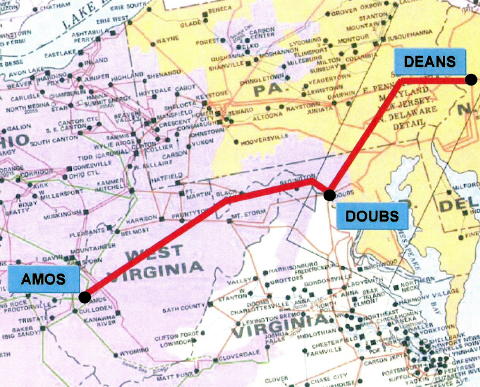CALHOUN HEARINGS LIKELY ON BEHEMOTH POWER LINE - $3 Billion Project Could Cross County

By Bob Weaver
A Virginia public relations firm Commonwealth Associates is doing some research regarding the location of a behemoth high-tower electric transmission line that could cross Calhoun County.
The $3 billion line would stretch from the John Amos power plant in Putnam County across several West Virginia counties into Maryland, delivering electric to the northeast corridor into New Jersey.
The public relations firm said it is likely they will be coming to the county to hold a public meeting to generally discuss the location of the multi-billion dollar project.
While the companies say they are willing to work with landowners, they have been given the right of imminent domain by the Bush administration.
Last October the Bush administration designated swaths of the eastern United States, including 41 of West Virginia's 55 counties, as critical to the nation's energy grid.
That designation allows new high-transmission lines to be built despite state or any local opposition - a right of imminent domain for a cause that exceeds personal property rights.
American Electric Power and Allegheny Energy are working on the joint venture project.
The Hur Herald drew a straight-line from the Amos Plant to the Maryland connector in 2006, which indicated the line could go through the county.
Following a number of hearings, the project routes are then decided with three proposed routes placed on a map, after which further comment is requested.
In West Virginia, the Public Service Commission suggests the power companies use current right-of-ways to lessen impact, which could deviate from a straight-line route.
Other transmission lines proposed in the eastern part of West Virginia have been met with considerable resistance.
Early reports said the Amos Plant to New Jersey project was scheduled to be completed in 2014.
The West Virginia PSC has been lukewarm to the projects, indicating the state could bear the brunt with local coal-burning plants and lengthly lines to reach other states, suggesting consideration that plants and their lines should be placed closer to the communities they serve, mostly urban areas.
A previous concern was about charging WV customers for line construction.
The Federal Energy Regulatory Commission is allowing the joint venture to charge rates that will earn a 14.3 percent return on equity.
Dow Jones Newswires called the return "extremely high for a regulated utility project," and said, "the generous incentives provided reflect the government's desire to encourage new transmission lines to bring excess power from Appalachia and the Midwest to constrained areas in Maryland, Delaware and New Jersey."
"The project addresses significant reliability concerns, including overloads that will occur on more than 13 existing transmission lines in Maryland, West Virginia, Virginia and Pennsylvania as soon as 2012 if the line is not built," said Michael Morris, AEP chairman.
Still, the nature of the project appears to use a coal-fired power plant in West Virginia near the coal fields to generate electric for highly-populated urban areas in the northeast, as opposed to locating power plants near the areas of need.
While the John Amos plant in Putnam is upgrading environmental controls, environmental groups say the plant has a long way to go to actually correct pollution problems.
"The companies anticipate seeking regulatory approvals for the project from the utility commissions in both West Virginia and Maryland in the fourth quarter of 2008, following the completion of the routing studies," AEP said.
The company's Appalachian Power subsidiary serves most of the southern half of West Virginia.
American Electric Power is one of the largest electric utilities in the United States, delivering electricity to more than 5 million customers in 11 states.
Allegheny Energy, which serves customers across the northern half of West Virginia, has also proposed construction of a transmission line that would extend from a point south of Pittsburgh to Middletown, Va.
About 114 miles of that line would be across West Virginia, passing to the west of Morgantown in Monongalia County and crossing Preston, Tucker, Grant, Hardy and Hampshire counties.
Allegheny has met stiff resistance from some landowners and community groups in Monongalia and Tucker counties.
Last October business, labor and lobbyist representatives created "West Virginians for Reliable Power," a group organized to push for the giant transmission infrastructure.
Will Giant Electric Transmission Line Come Through Calhoun County?
Mega Powerline Projects Being Challenged
Rates For Giant 290-Mile Transmission Line
Giant Powerline...Finalize Project